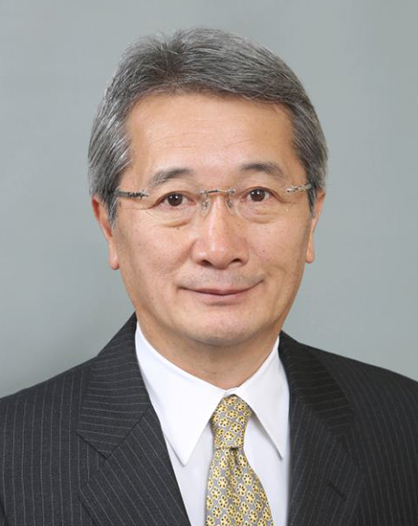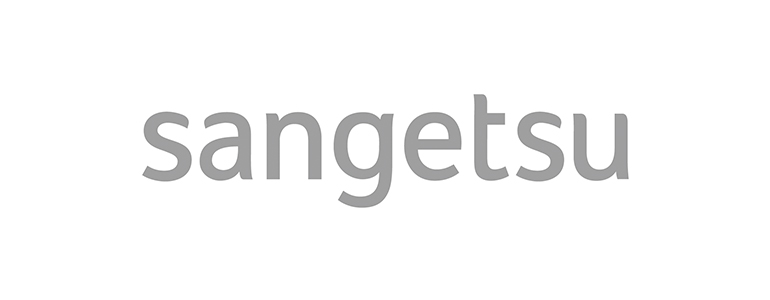| Sangetsu Corporation (8130) |
|
||||||||
Company |
Sangetsu Corporation |
||
Code No. |
8130 |
||
Exchange |
First Section, Tokyo and Nagoya Stock Exchanges |
||
Industry |
Wholesale (Commerce) |
||
President |
Shousuke Yasuda |
||
HQ Address |
1-4-1 Habashita, Nishi-ku, Nagoya-shi |
||
Year-end |
March end |
||
URL |
|||
* Stock price as of closing on June 13, 2017. Number of shares issued at the end of the most recent quarter excluding treasury shares.
ROE and BPS are based on the previous year. |
||||||||||||||||||||||||
|
|
* DPS of March 2013 included commemorative dividend of ¥3.
* Estimates are those of the Company. 2 for 1 stock splits were conducted in April 1, 2015. * From the current fiscal year, the definition for net income has been changed to net income attributable to parent company shareholders (Abbreviated as parent net income). |
| Key Points |
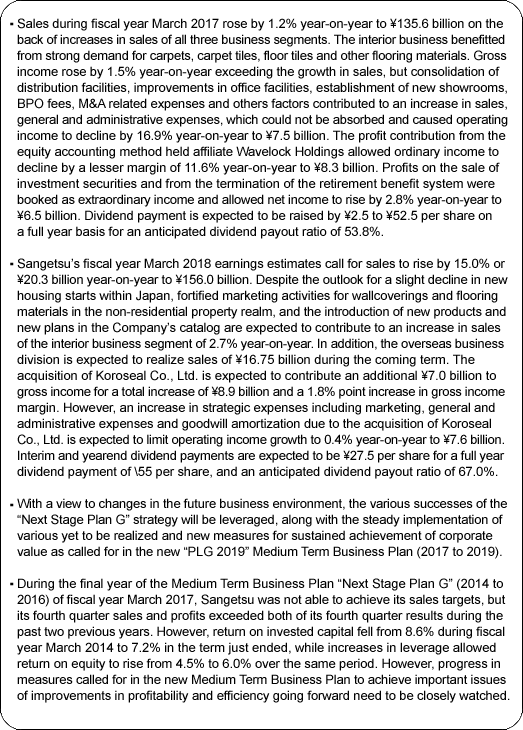 |
| Company Overview |
|
The Sangetsu Group is comprised of six companies including Sangetsu (Shanghai) Corporation, the company responsible for business in China, "Koroseal Interior Products Holdings, Inc.", the United States company conducting sales of wallcovering materials for non-residential applications, Fairtone Co., Ltd., that seeks to grow orders on the back of increases in installation capabilities, Sungreen Co., Ltd., a dedicated distributor of exterior products, and Yamada Shomei Lighting Co., Ltd., a planner, designer, manufacturer and distributor of lighting equipment, and "Sangetsu Vosne Corporation", specialized in curtain fabrics <Corporate History>
Sangetsu was founded in 1849 under the original name of "Sangetsudo" to sell various traditional Japanese interior decorating products including scrolls, wall scrolls, folding screens, sliding doors, partitions, and other products made of cloth and paper. Sangetsu Corporation was incorporated in 1953 by the founding family. From the latter half of the 1970s onwards, the business was expanded into Tokyo, Fukuoka, Osaka and other parts of Japan. In 1980, Sangetsu was listed on the Second Section of the Nagoya Stock Exchange, and later in 1996 its shares were also listed on the First Section of the Tokyo Stock Exchange. Currently, Sangetsu is expanding its operations into overseas markets and has established itself as the largest total interior decorating product provider within Japan, with a widely recognized brand of interior products.Shosuke Yasuda was appointed as the first President who is not from the founding family of Sangetsu in April 2014. He will direct the Company during its third stage of growth entitled "Our Third Founding Phase," following on the heels of the original first phase of founding and the second phase when the company became a publicly listed corporation. <Corporate Philosophy>
Sangetsu established a new corporate philosophy including a new brand philosophy in April 2016 that will enable it to take on the challenge of implementing reforms necessary to take it to its next stage of growth.A new "brand philosophy" has been added to the "corporate creed," "corporate mission," and "Three Principles of Sangetsu" to create an expanded corporate philosophy. <Corporate Creed> Integrity <Corporate Mission> To contribute to society through interior design and strive to create daily culture of enrichment <Three Principles of Sangetsu> Creative Designs, High Reliable Quality, Fair Price <Brand Philosophy> Sangetsu endeavors to share the joy of creating new value through interior business with all of its stakeholders. <Market Environment>
The market environment for the main wallcovering and flooring products is strongly influenced by trends in the Japanese construction market. Declines in new housing start arising from declining population and changing family structures within Japan, and deflationary trends have depressed sales of the interior products market as shown in the graph below.
◎ Overview 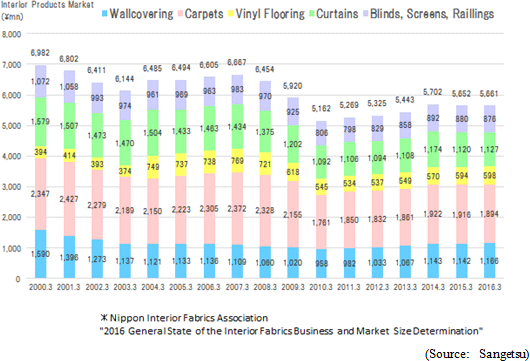 The trends for both Sangetsu's sales and the Japanese interior market have been closely linked to new housing starts. After the Lehman Brother's Shock however, this link has been overcome with Sangetsu's sales reaching consecutive record highs despite the sluggish trends in new housing starts and the weak overall market. 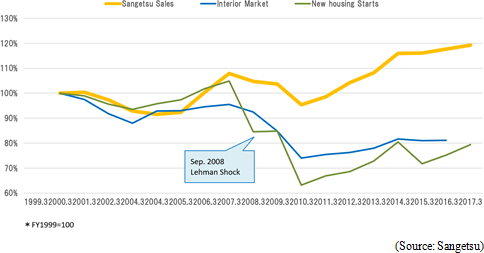 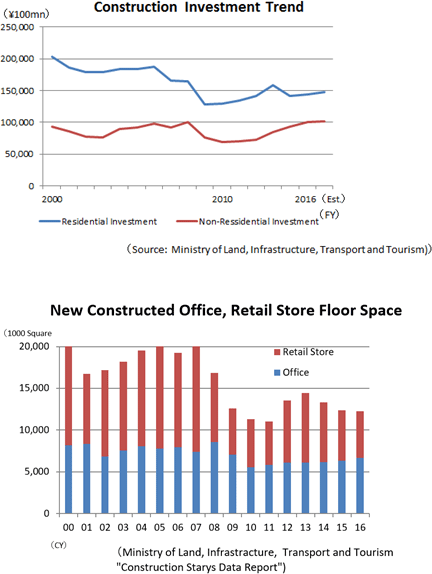 At the same time, the Research Institute of Construction and Economy report entitled "Construction Economy Forecasting Model for Construction Investments" released on April 26, 2017 estimates that private sector non-residential construction investments steadily rose by 9.4% and 5.6% year-on-year in fiscal years 2014 and 2015 respectively, but then its speed will be down in fiscal years 2016 and 2017 by 0.6% up and 1.2% down respectively. On a floor space basis, office space is expected to have grown by 12.1% year-on-year while retail store space to have fallen by 8.8% year-on-year in fiscal year 2016, while office space and retail store space both trended sideways at 0.0% in fiscal year 2017. Ahead of the 2020 Tokyo Olympic and Paralympic Games, private sector non-residential construction investments are expected to continue to trend strongly, despite some uncertainties clouding the near term horizon. ◎ Competitors
In addition to Sangetsu, there are three publicly traded competitors that operate in the interior decorating market.
 <Business Description>
The main businesses include planning, development, and sales of wallcovering, floor covering, curtains, upholstery and other interior products. Sangetsu boasts of a "fabless operation" and does not maintain any manufacturing facilities, but its capabilities exceed that of typical trading firms, and all of the products it sells are planned, designed and developed in-house. In addition, Sangetsu provides exterior products and lighting fixtures through its subsidiary.
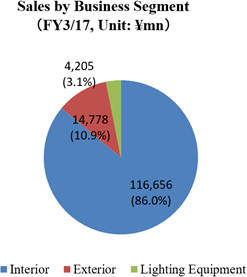 ① "Interior Business"
(FY3/17: Sales and Operating Income of ¥116.656 and ¥7.150 Billion) 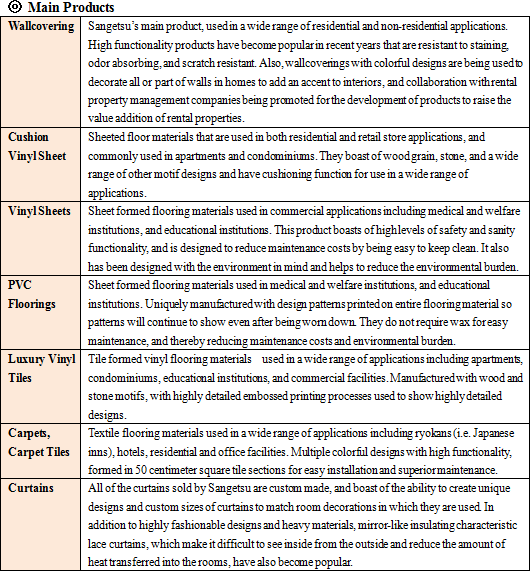 Replacement of existing products is not a simple task. Disposal of products leads to wastes, but the disposal of existing products due to replacement with newly designed products is necessary to maintain the attractiveness of the product catalog and to satisfy customers. Therefore, the ability to maintain a balance between attractiveness and efficiency is highly important and is one of the strengths of Sangetsu. ◎Sales Structure
In addition to the headquarters located in Nagoya, Sangetsu maintains 8 regional offices and 53 marketing offices throughout Japan, with 9 of these marketing offices also hosting showrooms.
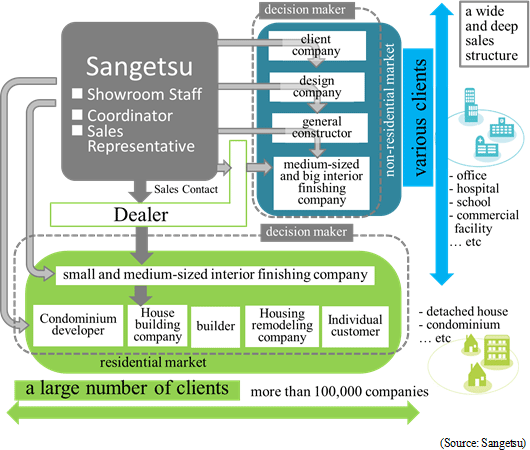 Therefore, Sangetsu conducts public relations and advertising for its products in its product catalog, at its showrooms, and so on. In addition to these "passive" marketing activities, Sangetsu also conducts "proactive" marketing of its products through its corporate marketing division and its 450 marketing staff to provide and gather information and propose products to clients. While the main marketing efforts are conducted through dealers, Sangetsu also conducts direct marketing to customers in the Nagoya and surrounding Chubu area, and the number of its directly accessed customer totals 6,000 in these regions alone. While the number of customers dealt with through dealers is not known, the total number of customers is estimated to amount to several tens of thousands nationwide. ◎Distribution Structure
Sangetsu maintains a network of 13 distribution centers nationwide. Most all products are normally stocked at the Company's distribution centers in Tokyo, Nagoya, Osaka and Fukuoka, with the number of products shipped from these centers surpassing 60,000 per day and the out-of-stock ratio amounting to a low 0.14% (About 70 products) per day.Sangetsu seldom asks their clients for backordering because the out-of-stocks are covered by surrounding distribution centers immediately. Sangetsu's nationwide distribution network makes "Just-in-Time" provision of products to match the interior construction schedules of its clients possible. Products are sourced from a wide range of over 100 supplier companies. ② "Exterior Business"
Sungreen Co., Ltd., which was turned into a subsidiary in 2005, sells doors, fences, terraces and other exterior products within Japan.
(FY3/17 Sales and Operating Income of ¥14.778 Billion and ¥402 Million) ③ "Lighting Business"
Yamada Shomei Lighting Co., Ltd., which was turned into a subsidiary in 2008, sells down lights, z-lights and other general lighting fixtures within Japan.
(FY3/17 Sales and Operating Income of ¥4.205 Billion and ¥ 23 Million)  <Characteristics and Strengths>
Sangetsu is a pioneer in the realm of "fabless companies" that do not maintain their own manufacturing functions and therefore have lower fixed expense burdens because they do not have to carry facilities for the manufacturing process. Besides, the Company boasts of over 13,000 products, sourced from over 100 suppliers, supplied to several tens of thousands of customers, which diversifies risk in many ways. Moreover, while Sangetsu may be considered as an economically sensitive company as its business and earnings performances are closely linked to trends in the construction market, the Company has never seen losses since its founding.
① Business Model Capable of Yielding Stable Earnings ② "Creating," "Proposing," "Providing"
While the actual manufacturing of products is not conducted in-house, Sangetsu performs the planning, design and development functions internally. The previous generation of Sangetsu management made active investments for "unique designs," one of the three principles of the Company. 25 in-house designers develop new and original versions of products based upon numerous basic designs. The cultivation of designers responsible for various products is done through participation in foreign exhibitions, communication with marketing staff, and discussions with outside design consultants as part of their on-the-job training. Furthermore, Sangetsu maintains a policy of actively taking the perceptions and opinions of younger designers and staff into consideration. Sangetsu also boasts of an overwhelming number of products of about 13,000 that far exceeds the number of products of its competitors. In addition, the Company conducts revisions of its products on a regular basis every 2 to 3 years with more than 30 types of catalogs, which far surpass those of its competitors.
"Creating" 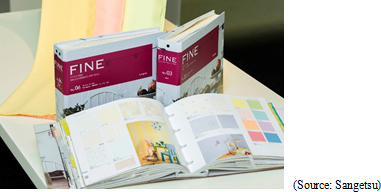 "Proposal based sales marketing"
Nearly one third of all employees or some 450 work in marketing functions at Sangetsu, the largest marketing function within the industry. These marketing staffs are assigned to 63 offices located throughout Japan and conduct proposal-based marketing to clients. Sangetsu also staffs its 9 showrooms with 45 employees. In addition, about 40 interior designers create design boards that combine samples of various products for customers to use when choosing interior products. This high level of proposal-based marketing capability is unmatched within the industry and sets Sangetsu apart from its competitors.
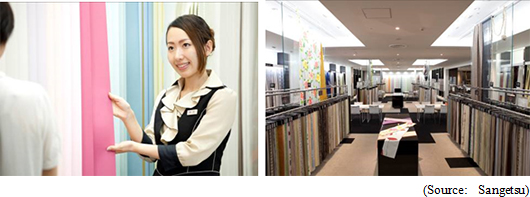 "Distribution system"
As mentioned earlier in this report, Sangetsu normally maintains inventories of all of its products so that they can be provided on a "Just-in-Time" basis using their nationwide distribution network. However, the Company is required to conduct speedy processing techniques as product orders are placed so that loss rates can be limited to avoid the maintenance of excess inventories and reduced efficiencies. Generally, wallcoverings are produced in rolls as long as 50 meters, and Sangetsu cuts these rolls into shorter segments when orders are placed for shipment. The remaining segments of wallcovering are then cut to match other orders to eliminate losses. This type of custom-made cutting technology has been cultivated over the long years of experience in the interior decorating business and is an important factor that differentiates Sangetsu from its competitors.
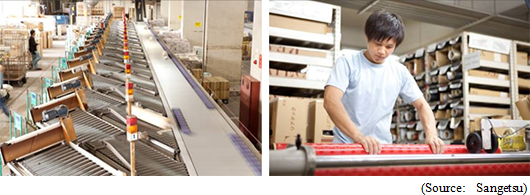 |
| Fiscal Year March 2017 Earnings Overview |
 Marginal Sales Increase, Profit Decline
Sales rose by 1.2% year-on-year to ¥135.6 billion on the back of increases in all three business segments, with particular strength noted in the interior business due to strong demand for carpets, floor tiles and other flooring materials. The growth in gross income exceeded that of sales at 1.5% year-on-year, but costs arising from consolidation of logistics facilities, improvements in office facilities, newly established showrooms, shift to a business process outsourcing (BPO) model, M&A related activities and other sales, general and administrative expenses were left unabsorbed and caused operating income to decline by 16.9% year-on-year to ¥7.5 billion. The booking of investment profits on equity accounting method from Wavelock Holdings Co., Ltd. of ¥0.32 billion allowed ordinary income to decline by a lesser margin of 11.6% year-on-year to ¥8.3 billion. Profits on sale of investment securities and from retirement benefit system termination of ¥0.8 and ¥0.1 billion respectively were booked at the extraordinary income level and allowed net income to rise by 2.8% year-on-year to ¥6.5 billion. Dividends are expected to be increased from initial estimates by ¥2.5 to ¥52.5 per share on a full year basis, for an anticipated dividend payout ratio of 53.8%.
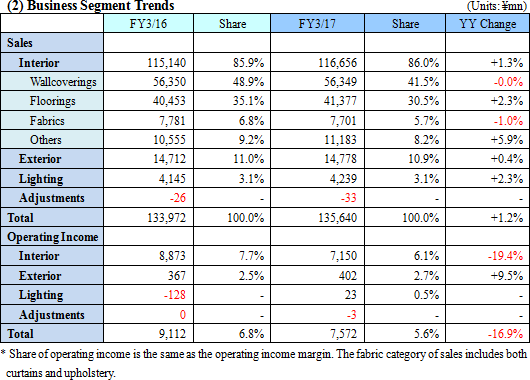 ① Interior Business
Higher Sales, Lower Profits<Wallcovering Materials> Sales of wallcovering materials trended in line with the previous term. Strong new housing starts contributed to strong trends in rental residential properties, but lackluster growth in new single dwelling residential units and the high exposure of wallcovering to single dwelling units contributed to weak earnings of the wall covering materials division. At the same time, efforts were made to capture refurbishment demand from commercial facilities and hotels through strengthened marketing efforts leveraging the newly published "FAITH" catalog, which includes non-flammable wallcoverings. <Flooring Materials> Flooring materials trended strongly. In the flooring materials division, sales of specially designed carpets and carpet tiles rose strongly on the back of strong refurbishment demand from hotels providing accommodations to inbound travelers from overseas. In addition, sales of PVC floor tiles expanded on the back of strong demand from rental residential properties. <Fabric Materials> Sales of fabric materials declined. In the fabric materials division, Sangetsu published a curtain catalog containing products for use by medical facilities, hotels and other users in the contract market and strengthened its sales activities for non-residential construction applications. Furthermore, they also published a new chair fabric catalog, and strengthened their marketing activities to acquire new customers in the furniture manufacturing and contract markets. Despite these efforts, weaker demand for custom made curtains in the residential property applications contributed to lower sales. ② Exterior Business
Sales trended in line with the previous year's levels, but profits rose by double digits.In the exterior business conducted by Sungreen Co., Ltd., restructuring was undertaken to strengthen the sales management structure and synergies with the marketing activities with Sangetsu were pursued amidst intensifying competition. ③ Lighting Business
Sales rose, and turned profitable.In the lighting business conducted by Yamada Shomei Lighting Co., Ltd., pricing competition is intensifying along with the rapid expansion of low energy consumption LED lighting usage. Also, marketing activities are being focused upon design offices and developers with a goal of cultivating business opportunities in the strategic market of non-residential properties in the Tokyo metropolitan area. Consequently, success has been achieved in capturing demand for contract projects from large office buildings, hotels and commercial facilities, which in turn allowed profitability to be achieved. 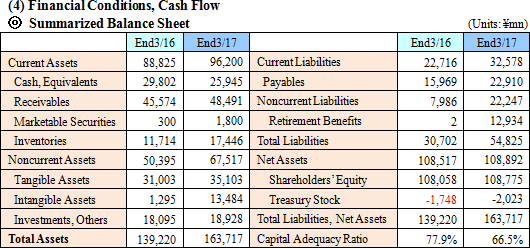 Current assets rose by ¥7.3 billion from the end of the previous term. Noncurrent assets rose by ¥17.1 billion, along with a ¥24.4 billion rise in total assets to ¥163.7 billion over the same period. Current liabilities also rose by ¥9.8 billion. Long term debt from syndicated loans for use in M&A activities grew by ¥12.9 billion, causing noncurrent liabilities to rise by ¥14.2 billion and total liabilities to grow by ¥24.1 to ¥54.8 billion. Net assets remained nearly unchanged at ¥108.8 billion and capital adequacy ratio declined by 11.4% points to 66.5%.  Along with the payment for acquisition of shares accompanying the conversion of Koroseal of the United States into a subsidiary, decline in income arising from disappearance of the redemption of investment securities in the previous term caused both investing and free cash flows to turn from net inflows in the previous term to net outflows in the current term. The assumption of long term debt caused financing cash flow to turn from a net outflow in the last term to a net inflow in the current term. Cash position declined. |
| Fiscal Year March 2018 Earnings Estimates |
 Sales to Rise by Double Digits, Operating Income to Trends Sideways
Sales are expected to rise by 15.0% or ¥20.3 billion year-on-year to ¥156.0 billion despite the outlook for a small decline in new housing starts. Sangetsu will strengthen its marketing activities for wall coverings and floor coverings to non-residential property applications, and introduce new products and publish new catalogs with a goal of growing sales. The anticipated increase in sales of the interior business also includes sales amounting to over ¥3.0 billion derived from the consolidation of Fairtone Co., Ltd., in addition to ¥16.7 billion in overseas sales expected to be derived from the consolidation of Koroseal which was acquired in November 2016.Gross income is expected to grow by ¥8.9 billion, including some ¥7.0 billion from the acquisition of Koroseal, and gross income margin is expected to rise by 1.8% points. The consolidation of Koroseal is expected to lead to ¥5.4 billion in addition sales, general and administrative expenses, a ¥0.6 billion increase in goodwill amortization, and an ¥8.8 billion increase in strategic expenses. These additional expenses are expected to limit growth in operating income to a marginal 0.4% year-on-year to ¥7.6 billion. Interim and yearend dividends of ¥27.5 per share are expected to be paid, for a full year dividend of ¥55 per share and an anticipated dividend payout ratio of 67.0%. 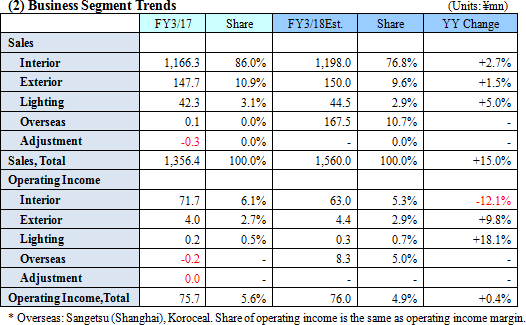 |
| "PLG 2019" Medium Term Business Plan (2017-2019) |
|
1. Reflecting Upon the "NEXT Stage Plan G" Previous Medium Term Business Plan
The three year period from 2014 was identified as the "Third Founding Phase" in which Sangetsu sought to establish a new management structure which had previously been comprised primarily of the founding family members. At the same time, the "Next Stage Plan G" (2014 to 2016) Medium Term Business Plan was created with a goal of promoting development of Sangetsu as a publicly traded company where its employees take responsibility for management and measures are implemented to create a new business structure strategy that can capture future business opportunities for growth.
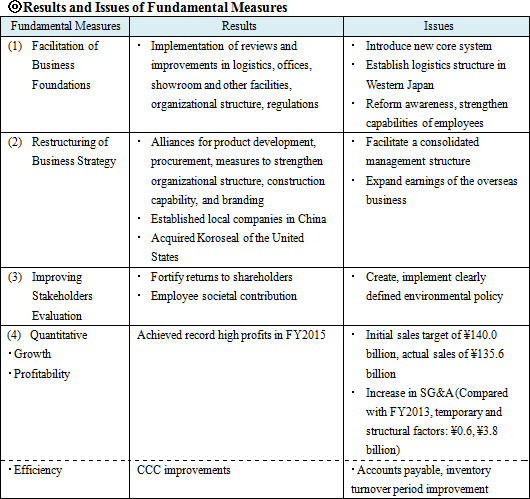 In addition, Sangetsu was able to steadfastly implement "measures to achieve future growth", despite not being able to achieve its goals of expanding and improving earnings of its affiliated companies, strengthening its front line sales, optimizing transportation, strict control of sales, general and administrative expenses, and its most important goal of "heightening the awareness of employees to take on responsibility for management". 2. Medium Term Business Plan "PLG 2019" (2017-2019)
With a view to potential changes in the future business environment, Sangetsu will leverage the various successes achieved in the "Next Stage Plan G" Medium Term Business Plan and will implement measures to realize those goals yet to be realized and to achieve sustained creation of corporate value of Sangetsu Group in the new Medium Term Business Plan "PLG 2019" (2017 to 2019).
①Business Recognition
Because Sangetsu conducts a difficult business model that serves a wide variety of customers with a wide variety of product needs in small lots, the risk of competition from new market entrants is relatively low. At the same time, the Company needs to attain economies of scale to secure profits.
(Interior Business Characteristics) (Worldwide Market)
Looking at the global wall covering materials markets, Japan, China, Russia, other Asian markets, Europe and the United States are estimated to consume 670, 1,570, 950, 530, 520 and 110 million square meters of wallcovering. And while Japan is a significant consumer of wallcovering, it can be said that the overseas markets are huge relative to Japan.According to the same survey, the growth rates in the value of construction investments (From 2017 to 2019) are expected to decline in Japan for residential properties, but grow by 3% to 5% in non-residential properties. In the United States, growth in non-residential property construction investments is anticipated to grow between 5% and 7%, and by 8%, 7% and between 6% and 7% in India, Indonesia, and Vietnam respectively. At the same time, China, Singapore and Thailand are expected to see a growth rate of between 3% and 5%. (New Direction of Growth)
Sangetsu went through a period of growth from 1953 to the first half of the 1990s from its origins in the Tokai region of Japan, and achieved domination of the nationwide market. With regard to sales, Sangetsu relies primarily upon dealers who sell BtoB in limited positions.In addition to wallcovering and flooring materials, the Company has expanded its scale by deploying a business model that covers a wide range of interior products including a diversified lineup of fabrics as well. However, Sangetsu entered a period of stability during the latter half of the 1990s after it conquered the nationwide market. The Company also encountered the issues of how to come up with adequate responses to deal with diversification of the market and expansion in the consumer market, and how to provide support of sales by dealers and construction companies. In addition, Sangetsu was confronted with the issue of how to deal with large changes in the procurement environment with the rapid increase in size of overseas product manufacturers and the consolidation of the Japanese market with product suppliers suffering from a game of survival of the fittest. In order to overcome these difficult conditions, Sangetsu started to promote a "global market approach" for its regional business strategy from 2014, with a goal of accurately responding to the needs of a diversifying market by providing a deeper and wider range of products. Moreover, Sangetsu has pursued higher levels of specialization and more comprehensive capabilities as a means of providing customers with higher levels of value addition. Furthermore, the procurement function has been strengthened by active pursuit of alliances with product manufacturers both within and outside of Japan. ②Medium Term Business Plan "PLG 2019" (2017-2019) Overview
Based upon the "Corporate Creed: Integrity" and "Brand Philosophy: Joy of Design", Sangetsu has created its Medium Term Business Plan "PLG 2019" with the goal of establishing strong roots within both the Japanese and overseas markets by leveraging the Group's "diversified product lineup and highly specialized knowledge".◎Vision "P" stands for personal and reflects the highly professional employees that helps it to link to people outside of the Company. "L" stands for local and refers to the strong positioning in local markets. "G" stands for global and represents Sangetsu's global lineup of products and designs. 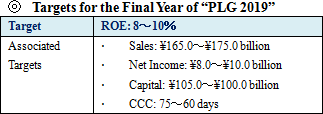  ◎Themes
As a basic policy, Sangetsu has identified the following measures as part of its strategy of "strengthening the function and expanding geographic sales of the interior materials business (planning, procurement, logistics, sales)".
(1) Business Strategy for Growth
①Realizing Stable Growth in Earnings through Expansion and Strengthening of the Value Chain Activities Realm in Japan as a Fundamental and Stable Source of Revenues
Sangetsu will promote "development and procurement of materials and raw materials through alliances with superior suppliers within and outside of Japan", "strengthen interior coordinator proposal and installation capability", "fortify alliances and cooperation with dealers" and "conduct reviews of internal sales structure".
②Strengthen Activities in Overseas Markets with High Growth Potential, Fortify Product Lineup and Functionality to Promote Geographic Expansion
Local logistic and sales structures will be strengthened in important markets including North America, Asia and others.
③Create a Global Product Planning, Procurement Structure to Promote Global Designs, Cultivate Global Product
Sangetsu will strengthen cooperation with local facilities in Japan, United States and China for the implementation of "cooperation between Sangetsu globally and superior overseas product manufacturers" and "efforts to promote joint marketing of products and deployment of European and Japanese designs".
④Strengthen Consolidated Management Structure to Pursue Comprehensive Synergies, Integrated Management of Affiliates Responsible for Special Markets, Functions and Geographic Regions
A management structure system will be introduced to maximize business synergies and conduct clearly controlled earnings management, and to act as a surveillance support structure for the overall Group.A consolidated management division will be newly established with authority to oversee the entire Group. In addition, regularly scheduled monitoring and communications will be introduced to increase the overall effectiveness of the Group. ⑤Business Format Conversion Trials to be Conducted with a View to the New Medium Term Business Plan
In order to pursue synergies and leverage business resources and the characteristics of each Group company, Sangetsu will conduct trials and promote business format conversion.
(2) Strengthen Human Resources
In order to cultivate real professionals, all of the Sangetsu Group companies will implement measures to 1) cultivate professional human resources, 2) conduct strict adherence to performance, 3) promote diversity, 4) reform work styles and 5) maintain a healthy management structure.
(3) Strengthen the Earnings Management Structure
①Strict Control, Reduction of Sales, General and Administrative Expenses
A chief cost controller will be appointed, and sales, general and administrative expense control methodologies will be facilitated. Also, the total number of staff of the parent company Sangetsu will be reduced.
②CCC Management Will be Introduced for All Group Companies
Targets for return on equity and CCC management through Dupont analysis on a consolidated basis will be promoted.
③Sangetsu to Clearly Define and Promote Management Benchmarks for Each Business, Company
Targets for sales and gross income by employee will be established for each of the Group companies.
(4) ESG/CSR Policies
①E: Environment
②S: Society
③G: Governance
(5) Capital Policy
①Financial Policy for Improvement of Capital Efficiency
Sangetsu will continue to conduct share buybacks and stable increases in dividend payments with a goal of reducing its net worth to between ¥100.0 and ¥105.0 billion (¥108.8 billion as of FY3/17) with a view to conditions within the capital markets.
②Shareholder Return Policy of the Medium Term Business Plan
 |
| Conclusions |
|
Also, return on invested capital declined from 8.6% in fiscal year March 2014 to 7.2% in fiscal year March 2017 and return on equity rose from 4.5% to 6.0% over the same period due in part to the increase in leverage. Consequently, measures implemented to raise profitability and efficiency are important factors. Also, progress in measures defined in the new Medium Term Business Plan will need to be watched closely. 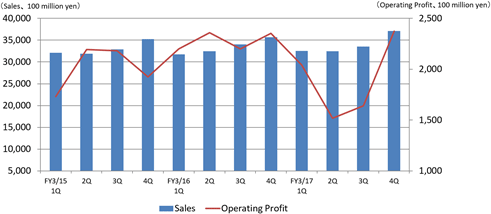 |
| <Reference: Regarding Corporate Governance> |
 ◎ Corporate Governance Report
Last modified: March 28, 2017.<Reasons for Non-compliance with the Principles of the Corporate Governance Code (Excerpts)> The company implements each principle of the Corporate Governance Code. 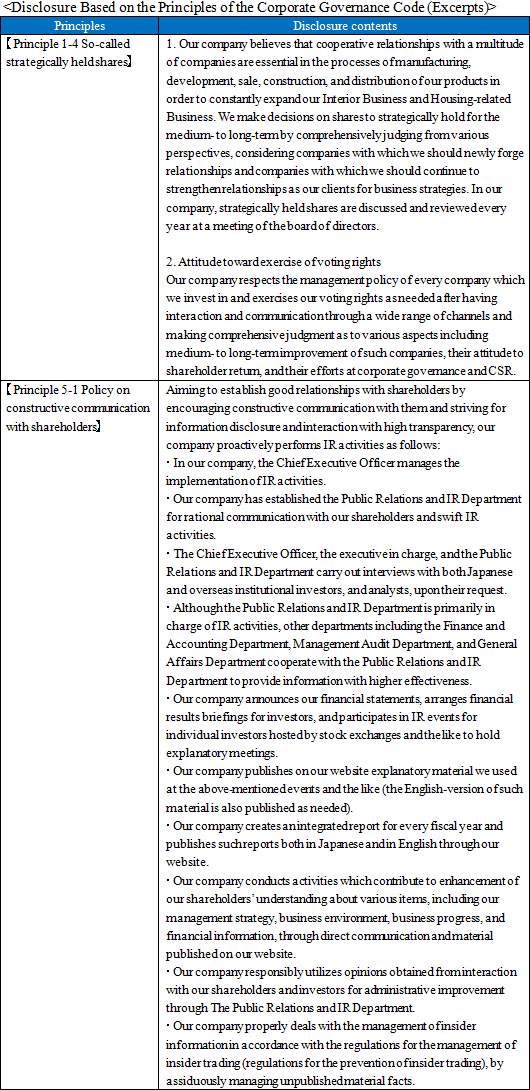 Disclaimer
This report is intended solely for information purposes, and is not intended as a solicitation to invest in the shares of this company. The information and opinions contained within this report are based on data made publicly available by the Company, and comes from sources that we judge to be reliable. However we cannot guarantee the accuracy or completeness of the data. This report is not a guarantee of the accuracy, completeness or validity of said information and or opinions, nor do we bear any responsibility for the same. All rights pertaining to this report belong to Investment Bridge Co., Ltd., which may change the contents thereof at any time without prior notice. All investment decisions are the responsibility of the individual and should be made only after proper consideration.Copyright(C) 2017 Investment Bridge Co., Ltd. All Rights Reserved. |

